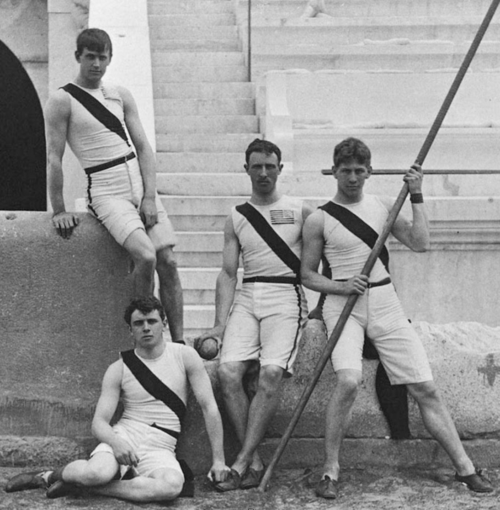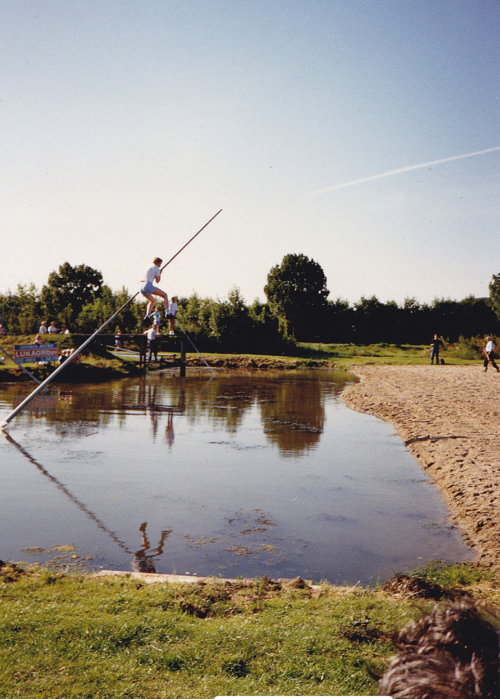
Far right: Albert Tyler
IOC/Olympic Museum /Allsport
In a black and white photo from 1896, four men pose with straight faces on a stone ledge in Athens, Greece. Each wears a white sleeveless shirt with a diagonal stripe, white shorts, and spiked track shoes made with leather. The man on the far right holds a long bamboo pole, used for pole vaulting. Few people know the story of how four Princetonians—Francis Lane, Herbert Jamison, Robert Garrett, and Albert Tyler—competed in the first modern Olympic Games, except perhaps the archivists at Mudd Library where Lane’s scrapbooks are kept.
The 14-person 1896 U.S. Olympic team was thrown together at the last minute by Princeton history professor Dr. William Sloane. Sloane was interested in sports only “from a moral view” and believed that bringing “higher-class” (read: Ivy League) athletes together from different countries would lessen discord among nations. Besides Tyler, Sloane recruited three other Princeton junior athletes. Three of the four—team captain Robert Garrett, 400-meter dasher Jamison, and pole vaulter Tyler—were members of the Tiger Inn Club. Garrett’s mother paid for the athletes’ travel: a boat to Gibraltar, a steamer to Naples, a train to Brindisi, a steamer to Greece, and finally a train to Athens.
Robert Garrett had never even seen a discus before, so Dr. Sloane suggested he create a practice discus based on an image of an ancient Greek statue. Accidentally—and perhaps fortuitously—his practice discus was five times as heavy as a real discus. Garrett ended up winning his Olympic discus event. Tyler himself came away from the first Games with a bronze medal in pole vaulting. This means he was second place; gold medals would not exist until the 1904 Olympics.
In 1896, there was also no NBC and no high definition TV. The results of the Games would have fallen into the annals of history had they not been written up in reports requested by United Press International in London. Albert Tyler was probably the author of these reports. He went on to publish a piece about the Olympics in the Princeton school paper. His experience was relatively typical of Olympic athletes at the time: most were amateurs. In fact, professional athletes were not allowed to compete in the Olympics until the 1970s.
Albert Tyler is the athlete of most interest to me. When my dad sent me an email out of the blue, with a list of people who had once lived in our house—his normal passion for family genealogy channeled into house genealogy—I found out Tyler was one of my house’s earliest residents, and coincidentally, he also went to Princeton.
Princeton’s Class of 1897 included 195 males, nine of whom were from Ohio, four of whom were named Albert. Albert Clinton Tyler was one of the year’s more unusual graduates. He grew up in Wyoming, Ohio, in a gabled Victorian house. He was voted “Best All-Around Man” in his class at Princeton—he was on the football, track and baseball teams. He also had a creative streak; the Princeton Alumni Weekly notes that the class birthday and Christmas cards were “examples of his expert craftsmanship in illumination and design.” Most notably, of course, Tyler competed in the 1896 Olympic Games in Athens, Greece: the first Games in fifteen hundred years.
Tyler’s sport was pole vaulting, not one of the most well understood nor most popular sports. What is pole vaulting? The practical and competitive history of this track and field event is extensive. The ancient Greeks pole vaulted over enemy walls and onto animals like horses. In the marshy Netherlands, along the North Sea, and in the Fens, people used poles to catapult themselves over obstacles. Picture a scene from Graham Swift’s Waterland—rich wetlands and peat bogs, cattails and reeds. After artificial draining of the marshy Fens, canals were formed. These necessitated the use of jumping poles, which many people kept in their homes for convenience. Gondoliers in Venice traditionally used poles to get to their boats. Oil paintings from the thirteenth century depict Dutch leaping over canals using poles. They were rumored to be the first to actually create a sport, Fierljeppen, out of pole vaulting over canals. The first official Fierljeppen match took place in 1771. In 1775, German gymnastics began to incorporate poles into jumping events. Germany first held “running pole leaping” competitions in 1850. England also has an early tradition of the sport, using hardwood poles with iron spikes. Because hardwood poles had no bend, bamboo poles were created. Modern poles are made of fiberglass and carbon fiber.

The region of Ohio where Tyler was born in 1872 contained no Fen-like marshes, nor really any kind of notable element that could have inspired an athlete to pursue pole vaulting. Hamilton County is located in the very farthest corner of southwest Ohio, nestled in the Ohio River Valley. It was the second county created in all of the Northwest Territory in 1790. Wyoming is on the west side of Cincinnati, in Mill Creek Valley. Today, Ohio has a national pole vault convention, annual high school pole vaulting state championships, and various pole vaulting clubs and academies.
Pole vaulting necessitates all-around ability: sprinting speed, high jumping, and throwing strength combined. For those who haven’t ever attended a Princeton track meet (such as myself), there are four components to a successful pole vault: the approach, the plant or take-off, the swing-up, and the push-off. During the approach, the athlete builds speed. He holds the pole vertically by one end and lowers it as he nears the box and pit. The box is a sloping hole that allows the pole to slide to the end of the box. The foam pit cushions the vaulter’s landing. As the vaulter nears the box, he lowers his pole, switches his hands, and slows to gather himself. To take-off, he slides the pole tip to the back of the box and jumps up. His arms extend straight up and his back arches. The pole bends. Momentum builds. The vaulter swings his body forward and then pulls up his legs over his head. The result should be an upside-down handstand on top of the pole.
In the push-off, the vaulter and his pole part. He curls over the bar and rotates his body, falling onto his back. Guidebooks caution that as long as the vaulter is perfectly relaxed and confident, there is less chance of getting hurt when he lands—a conundrum for first time vaulters. (My grandfather, who later went to Princeton, stopped pole vaulting after falling and breaking his wrist as a high school beginner.) If the vaulter doesn’t clear the bar, he receives a result of “no height.” After three misses, the vaulter is out of the competition. The basic goal is to jump as far as possible. Tyler won second place with a 3.20-meter jump. Renaud Lavillenie holds the world record today for vaulting at 6.16 meters, or 20 feet and 2.5 inches.
After Princeton, Tyler became a schoolteacher and taught at Lawrenceville and Phillips-Exeter, among other prep schools. An advertisement in the 1901 New York Times announced his marriage to Saldee Bartine, which took place in the Nassau Presbyterian Church. Later he was head of the mathematics department at Haverford School in Pennsylvania. In 1945, on vacation in Maine, Tyler died of pneumonia. Tyler called his seventy-three years of life “knots of remembrance in the thread of Time.”
Unbeknownst to him, Tyler was at the vanguard of a glorious tradition. Despite its haphazard assembly by Dr. Sloane, the 1896 U.S. team shocked America by winning eleven Olympic championships. The U.S. won every single Olympic pole vault title from Tyler’s day until 1968. It holds forty-four Olympic medals for the pole vault; the country in second place holds only five. Since Tyler, the Olympic Games have hosted two residents of Wyoming, Ohio, and one hundred and fourteen Princetonians.